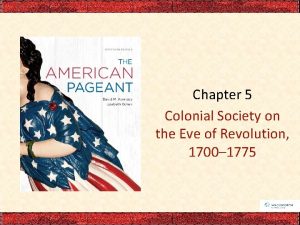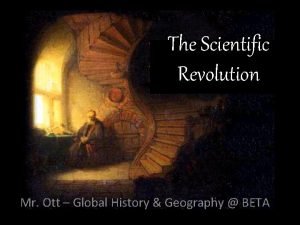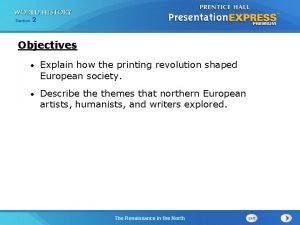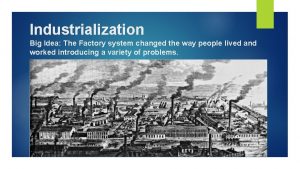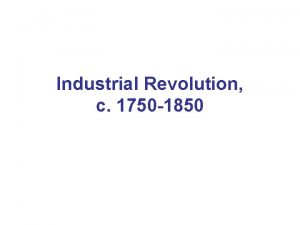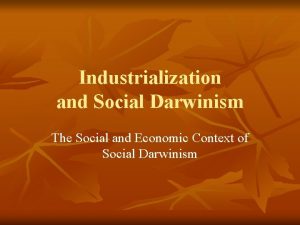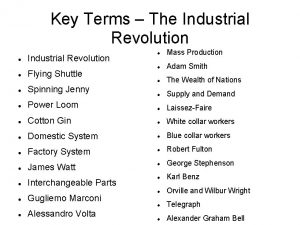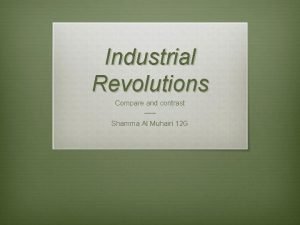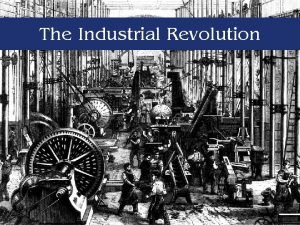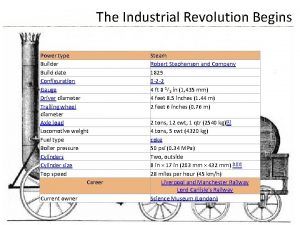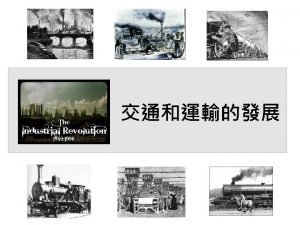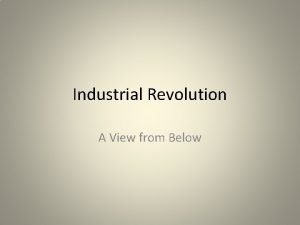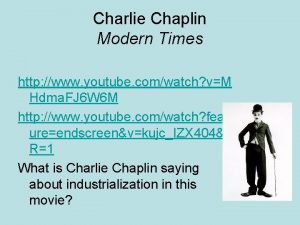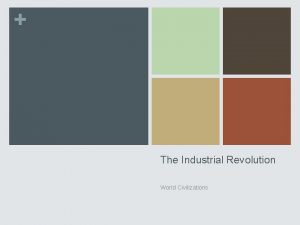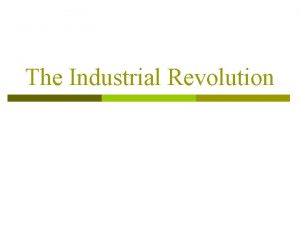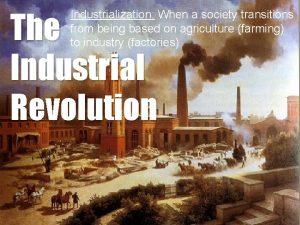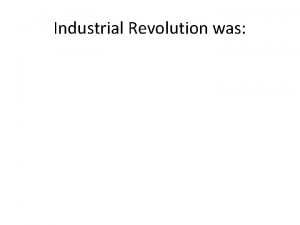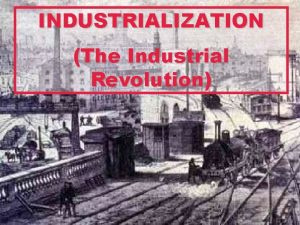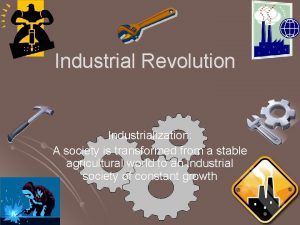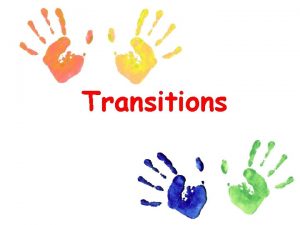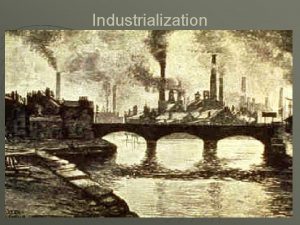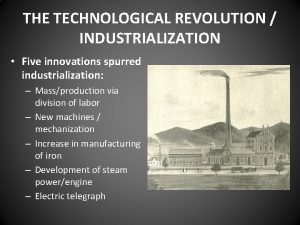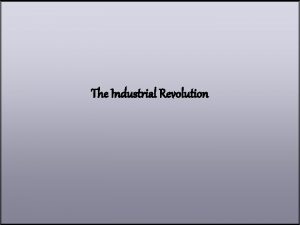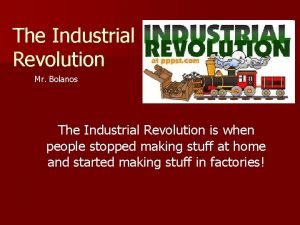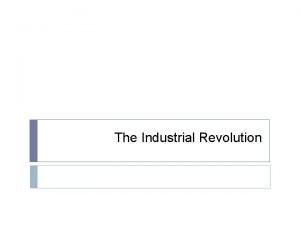The Industrial Revolution Industrialization When a society transitions























- Slides: 23

The Industrial Revolution Industrialization: When a society transitions from being based on agriculture (farming) to industry (factories)

Introduction � After the Civil War: � Reconstruction was going on in the South � Population was moving into the West At the same time, the cities were also undergoing a major change. � Rise of industry � New inventions made this possible

Transcontinental Railroad The railway completed in 1869 between Omaha, Nebraska and Sacramento, California It was built in large part by Chinese immigrants

Transcontinental Railroad


Bell develops telephone One of the most dramatic inventions of the late 1800 s was in the field of communications. In 1876, Alexander Graham Bell developed the first telephone, which revolutionized communication by increasing the scale and speed of nationwide communications. "Mr. Watson -- come here -- I want to see you. "

Edison and the Light Bulb In 1879, American inventor Thomas Edison developed the first commercial viable light bulb. The invention led to the wide spread use of electrical power and factories being able to run at night. Edison is considered one of the most prolific inventors in history, holding 1, 093 U. S. patents in his name.

The Bessemer Process The Bessemer process was the first inexpensive industrial process for the mass-production of steel. By the late 1880 s an immigrant by the name of Andrew Carnegie used this process to become a millionaire

Captains of Industry Entrepreneurs & Industrialists like Cornelius Vanderbilt, Andrew Carnegie, John D. Rockefeller and J. P. Morgan were able to build great fortunes during the Gilded Age Railroads Cornelius Vanderbilt Steel Andrew Carnegie Oil John D. Rockefeller Banking J. P. Morgan The government created policies to support the industrialists • High tariffs led to lower prices for American made goods • There were very few government regulations on big business • Government supported owners over workers in labor disputes

Captains of Industry … …or Robber Barons?

Monopolies A monopoly is having exclusive control of a commodity or service in a particular market.

Social Darwinism The belief that people and businesses who that cannot adapt to their environment will eventually “die out” “Survival of the fittest”

Child Labor Child labor included factory work, agriculture, or doing odd jobs

Child Labor Immigrant children were put to work in sweatshops – jobs with harsh working conditions

Child Labor Businesses wanted to hire children because they were a cheap source of labor.

Child Labor Children often worked in dangerous factory jobs…

Child Labor . . . or dangerous jobs in mines because of their size

Child Labor Newspaper carriers were known as “Newsies”

Triangle Shirtwaist Fire -146 women died in the factory fire, which was caused by unsafe conditions. -Led to NYC govt. investigation which led to improved safety conditions in factories.

Labor Unions A labor union is an organization of workers who unite to protect the rights of the workers from abusive practices of the employer

What is a Labor Strike? A labor strike is when a labor union refuses to go to work in order to shut down a business because of poor working conditions or poor pay

Eugene V. Debs was the powerful leader of the American Railway Union. Debs would run for president four times as a candidate for the Socialist Party, backed by unions

IWW (Wobblies) The International Workers of the World (IWW) called for all workers to be united as a class and demand better working conditions. The IWW, created in Chicago in 1905, was made up primarily of socialists and anarchists
 Third agricultural revolution
Third agricultural revolution Russian revolution vs french revolution
Russian revolution vs french revolution How could the french revolution have been avoided
How could the french revolution have been avoided Colonial society on the eve of revolution
Colonial society on the eve of revolution What did the first estate do
What did the first estate do Chapter 5 colonial society on the eve of revolution
Chapter 5 colonial society on the eve of revolution French society divided
French society divided Effects of scientific revolution
Effects of scientific revolution Colonial society on the eve of revolution
Colonial society on the eve of revolution Explain how the printing revolution shaped european society
Explain how the printing revolution shaped european society Whats the definition of industrialization
Whats the definition of industrialization Flying shuttle noon at ngayon
Flying shuttle noon at ngayon Social darwinism and industrialization
Social darwinism and industrialization How did the flying shuttle change the world
How did the flying shuttle change the world Shamma al muhairi
Shamma al muhairi Essential questions for industrial revolution
Essential questions for industrial revolution Multistory building divided into crowded apartments
Multistory building divided into crowded apartments Turnpikes industrial revolution
Turnpikes industrial revolution Population explosion industrial revolution
Population explosion industrial revolution Youtube chaplin modern times
Youtube chaplin modern times Positive effects of the industrial revolution
Positive effects of the industrial revolution Entrepreneurs industrial revolution
Entrepreneurs industrial revolution Enclosure movement industrial revolution
Enclosure movement industrial revolution Manchester in the industrial revolution
Manchester in the industrial revolution





